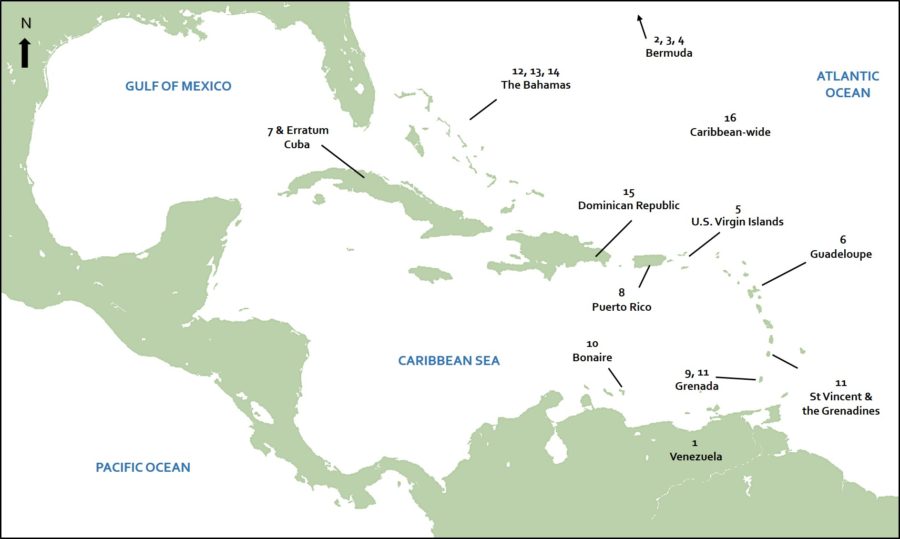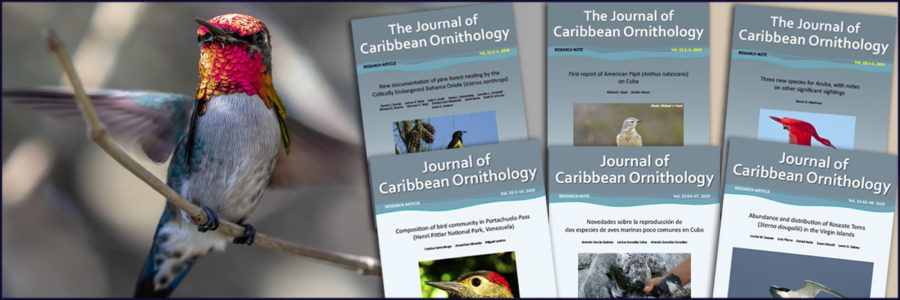Despite the challenges of the year 2020, JCO’s Volume 33 includes 16 publications, 3 book reviews, and a review of the recent ornithological literature from the Caribbean. The volume includes articles on a diversity of topics and taxa from 11 island territories and one Caribbean basin continental site. The content is a credit to all of the authors, reviewers, and JCO staff who overcame the pandemic challenges to contribute to the publication effort in a timely fashion. We thank all involved in this effort for their contributions, which have advanced our knowledge of Caribbean birds in 2020.
Please take some time to enjoy all of Volume 33. We should all take pride in this work and make the time to congratulate each other on all of these accomplishments, especially during this challenging year. If you enjoyed reading a publication, please send the authors a quick email letting them know. That is what makes Caribbean ornithology special—a sense of community and comradery unlike anywhere else.
— Joseph M. Wunderle, Jr., JCO Editor-in-Chief, and Justin Proctor, JCO Managing Editor
P.S. More good news: we have a lot of great manuscripts at various stages in the pipeline right now, which means that V34 is already off to a strong start!

RESEARCH ARTICLES AND NOTES
Cristina Sainz-Borgo, Jhonathan Miranda, and Miguel Lentino
In Henri Pittier National Park, Venezuela, the low-lying Portachuelo Pass provides essential habitat for both resident and migratory bird species. Despite this, information about the composition of the bird community is scarce. In this study, Sainz-Borgo et al. survey and describe the species inhabiting Portachuelo Pass, highlighting key characteristics of the avifauna in this important ecosystem.
Miguel A. Mejías and Albert J. Mejías
On 13 October, 2016, Hurricane Nicole made landfall over Bermuda. Mejias and Meijas acted quickly, utilizing the hurricane as an opportunity to document a species fallout event. Here, they present the results of their post-hurricane songbird surveys, documenting a significant fallout of Blackpoll Warblers and underscoring the importance of remote oceanic island refuges for fallout migrants.
Miguel A. Mejías and Erica Nol
While historically, Bermuda was home to lush, native, evergreen forests, human colonization in 1612 led to progressive habitat fragmentation and introduction of exotic trees. In this study, Mejías and Nol explore the impact of woodland size and vegetation features on species richness and bird abundance, specifically emphasizing the effects on White-eyed Vireos. Critically, they show that larger, less-fragmented woodlands are essential for supporting abundant and diverse bird communities.
David B. Wingate and Ian C.T. Nisbet
Early accounts from the Bermuda Islands suggest the presence of myriad nesting tern species on the islands; however, only the Common Tern survived into the 20th century. Here, Wingate and Nisbet review both the historic and recent records of terns on Bermuda, shedding light on the prospect of restoration and species recolonization using modern conservation techniques.
Louise M. Soanes, Judy Pierce, Daniel Nellis, Susan Zaluski, and Lewis G. Halsey
Due to a severe decline in the North Atlantic Roseate Tern populations in the 1900s, countries worldwide initiated conservation plans. However, few studies have focused on the Caribbean population of Roseate Terns. Using three decades of survey data, Soanes et al. detail the abundance and distribution of Roseate Terns in the Virgin Islands, identifying key breeding sites, reporting a gradual population decline, and calling for further conservation and research efforts.
Noah Perlut and Anthony Levesque
Though the Antillean Nighthawk is a relatively common species in the Caribbean, its migration routes and non-breeding location remain a mystery. In an effort to identify these locations, Perlut and Levesque attach a geolocator to a female Antillean Nighthawk, tracking and documenting her movements throughout a one-year period.
Antonio García-Quintas, Laritza González Leiva, and Ariandy González González
The second breeding record of Audubon’s Shearwater (Puffinus lherminieri) and the fourth breeding record of Common Tern (Sterna hirundo), were detected in the Felipe de Sotavento and Barlovento cays of northern Ciego de Ávila, Cuba. These seabirds are uncommon in the country; so, new records of nests with eggs and chicks indicate the need for increased sampling in northern cays of the country. The studied cays are among the most important nesting sites for seabird colonies in Cuba in terms of number of species and breeding pairs.
*Erratum: Novedades sobre la reproducción de dos especies de aves marinas poco comunes en Cuba
An error was found in the García-Quintas et al. manuscript published earlier in this volume, in which the photographs of an egg and chick in Figure 2 represent Roseate Tern (Sterna dougallii), not Common Tern (S. hirundo).
Adrianne G. Tossas, Osvaldo Rullán, Robert J. Mayer, and Jean P. González
Throughout the 20th century, Finca Nolla, a wetland on the northwestern coast of Puerto Rico, was severely disturbed by agricultural and industrial practices. However, in 2011, the Puerto Rico Department of Natural and Environmental Resources purchased the land, designated it as a protected area, and began restoration activities. By thoroughly documenting the avifauna within Finca Nolla, Tossas et al. establish a baseline for future avian assessments and propose an upgrade of the conservation status to nature reserve.
Wayne A. Smart, Natalia Collier, and Virginie Rolland
Historically, overexploitation has contributed significantly to seabird population declines. Though protective laws have since been enacted, the extent of continued, illegal seabird harvest is unclear. Through their survey of the fishers and recreationists at the Fisheries Division office in Sauters, Grenada, Smart et al. shine a light on the persistence of seabird harvest in Grenada, highlight the sociodemographic factors that are associated with seabird harvest, and propose a possible community-based monitoring program. Photo
Fernando Simal, Adriana Vallarino, Elsmarie Beukenboom, Rutsel Paula, Henry Beaumont, George Zaragoza, Esther Wolfs, Patrick Holian, and Elisabeth Albers
After anecdotal reports suggested that the seabirds roosting on the northwestern coast of Bonaire had been reduced to less than 60 individuals, Simal et al. began to investigate. From 2008–2010, they conducted roost counts at seven sites in Washington-Slagbaai National Park. Here, they document substantially higher seabird counts than previously suggested, with a maximum of 240 Brown Boobies in July 2009.
Juliana Coffey, Natalia Collier, Vaughn Thomas, and Romould Compton
Though historically considered very rare in the West Indies, Lesser Black-backed Gulls have become fairly common non-breeding visitors to many Carribean islands, including most of the larger Lesser Antilles. Continuing this trend, here, Coffey et al. document the first records of Lesser Black-backed Gulls on both Saint Vincent and the Grenadines and Grenada.
Ajay M. Patel and David W. Steadman
Despite the rarity of Burrowing Owls on Abaco, The Bahamas, today, many Pleistocene Burrowing Owl fossils have been recovered from the island. Using skeletal measurements, Patel and Steadman compare these fossils to modern specimens from western North America, South America, and Florida. Their results shed light on possible morphological adaptations of the Abaco owls to the island’s biogeography.
Briana M. Yancy, Janine M. Antalffy, Michael G. Rowley, Cierra N. McKoy, Daniel C. Stonko, Lebron E. Rolle, Jennifer L. Christhilf, Scott B. Johnson, Shelley Cant-Woodside, and Kevin E. Omland
Building on the first documentation of Bahama Orioles nesting in pine forests on Abaco, The Bahamas, in this study, Yancy et al. further characterize these nest sites. By identifying specific habitat characteristics that are important for pine forest nests, this work not only enhances our understanding of Bahama Oriole nesting ecology, but also helps inform critical conservation efforts.
Ruby Bagwyn, Kylen Bao, Zuzana Burivalova, and David S. Wilcove
The widespread use of the citizen-science database eBird offers a unique opportunity to analyze trends in bird populations. Here, Bagwyn et al. use eight years of eBird sightings to identify Bahamian bird populations that have recently gone unrecorded. Through this, they find 43 populations, representing 25 species, that are potentially declining or extinct, suggesting areas that should be of key conservation concern.
Qwahn D. Kent, Maia Edwards, Tim Wu, and André A. Dhondt
While other communal-nesting species show clear nest tree preferences, little is known about whether Palmchats prefer to nest in certain palm species over others. To investigate this gap, Kent et al. characterized Palmchat nest trees in Punta Cana, Dominican Republic. Overall, Palmchats nested more frequently in royal palms and Hispaniolan silver thatch palms compared with cana and coconut palms and in taller, thicker trees, regardless of tree species.
Ian C.T. Nisbet
The author sets out to bring attention to an ongoing misidentification problem between Roseate Terns (Sterna dougallii) and Common Terns (S. hirundo) on their breeding grounds in the West Indies and Bahamas. Observers should pay special attention to: adult bill color and breeding plumage, clutch size, and characteristics of nestling down feathers as well as leg color.
BOOK REVIEWS
The Real James Bond: A True Story of Identity Theft, Avian Intrigue, & Ian Fleming
Book author: Jim Wright
Review by: Steven Latta
Birds of the UK Overseas Territories
Book editor: Roger Riddington
Review by: Steven Latta
Birds of the West Indies: Second Edition
Book authors: Herbert A. Raffaele, James Wiley, Orlando H. Garrido, Allan Keith, and Janis I. Raffaele
Review by: Andrew Dobson
RECENT ORNITHOLOGICAL LITERATURE (ROL) FROM THE CARIBBEAN
ROL 2020
Steven C. Latta
Article by (1) Simon Campo – Editor for the Journal of Caribbean Ornithology and a Graduate Student at the University of California, Berkeley; Connect with Simon via LinkedIn or email; (2) Justin Proctor – Managing Editor for the Journal of Caribbean Ornithology; and (3) Joe Wunderle – Editor-in-Chief for the Journal of Caribbean Ornithology.
Journal of Caribbean Ornithology relies on donations to keep all of our publications free and open-access. If you’re interested in supporting our mission and the broader goal of giving a voice to Caribbean ornithologists and their work, please consider becoming a supporter of JCO. Thank you in advance!

